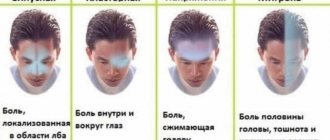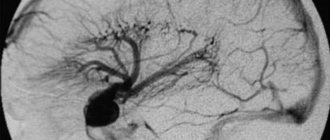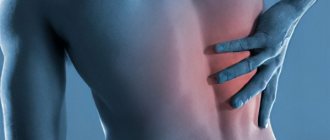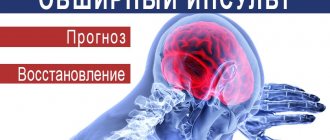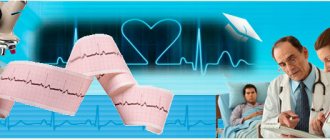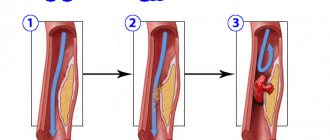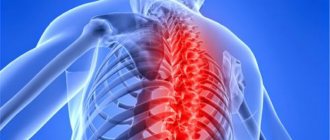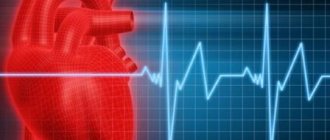Causes
Stitching pain in the right or left shoulder is a consequence of some disease and requires immediate treatment to avoid complications. The most common causes of this symptom are:
- incorrect posture and curvature of the spine (scoliosis, lordosis, etc.);
- inert, sedentary lifestyle;
- incompletely cured injuries that preceded shooting sensations in the shoulder area;
- constant loads and pressure on the shoulders, lifting heavy objects;
- sudden movements and waves of the arms;
- decreased immunity due to previous colds and infectious diseases;
- lack of calcium and other vital microelements in the body.
Etiology
Pain or discomfort in the chest area is a reason to consult a doctor. This is especially true for patients at high risk of developing a heart attack or other forms of coronary heart disease (CHD).
Mechanisms of chest pain:
- ischemia – a discrepancy between the need for oxygen for the operation of the main “pump” in the human body and the volume of its supply;
- inflammatory process of bacterial, viral or fungal origin;
- traumatic injury;
- neurological problems.
Depending on the mechanism of origin of the unpleasant symptom, its nature and the complaints with which the patient presents will differ. The doctor needs to quickly understand the situation to confirm or exclude life-threatening diagnoses and choose the optimal method of treating the person.
For example, if a patient comes to see me and complains that he has pain in his heart radiating to his left arm, I consider him first of all as a potential candidate for myocardial infarction. First, I need to exclude this diagnosis, and only after that can I carry out further differentiation in a calmer manner.
The most dangerous and common cause of pain in the chest area with migration to the arm remains myocardial infarction. The pathology is a form of coronary heart disease and annually claims millions of lives across the planet.
Characteristic signs of pain during a heart attack that everyone should remember:
- pronounced intensity (in 80% of cases);
- pressing or burning sensation. Patients sometimes say that “an elephant stepped on their chest”;
- duration more than 30 minutes;
- numbness or irradiation (spread) to the left arm, shoulder blade, corresponding half of the neck or jaw.
Patients with similar clinical symptoms are always urgently referred for specific diagnostics (ECG, blood test for troponin I, Echo-CG, coronary angiography) to verify the infarction and carry out appropriate treatment.
In addition to a heart attack, chest pain is often a consequence of the following diseases:
- Stable, variant and unstable angina. The principle of development of symptoms is the same as during a heart attack, but without myocardial necrosis.
- Pericarditis. Due to inflammation of the outer lining of the heart against the background of a bacterial, viral or fungal infection, specific receptors are irritated, which leads to the appearance of the symptom.
- Thoracic radiculitis. In this case, the pain in the heart is localized to a small area and has a stabbing nature. Noteworthy is the numbness of the hands and fingers, which develops due to compression of the nerve endings that emerge from the holes in the corresponding part of the spine.
- Myocarditis. The pain is less pronounced. Numbness of the hands in this case is much less common.
- Vegetovascular dystonia (VSD) (for more information about this condition, see the video below). Patients with this diagnosis almost always complain of heart pain. The sign may be accompanied by migration to the arm, but the severity of clinical symptoms is inferior to ischemic heart disease.
Timely diagnosis of the cause of acute pain will improve the prognosis for the patient and prevent the development of complications such as heart failure, fatal arrhythmias and myocardial ruptures.
Diseases
There are several specific diseases of the musculoskeletal system that affect the shoulder joints and cause unbearable pain. Moreover, unpleasant sensations usually appear when the disease has already entered the chronic stage. The most common ailments include:
- Bursitis. Often occurs as a result of heavy physical exertion. There is constant aching pain and swelling in the shoulder area; symptoms persist for several weeks. Severe pain is felt when raising or moving the arm to the side.
- Tendenitis. It often occurs in athletes and makes itself felt by constant friction of the tendon against the bone. It occurs as a result of frequent physical activity involving the hands and interferes with their free movement. Tendenitis affects swimmers, gymnasts, construction workers, etc. The disease usually manifests itself at night and is characterized by a sharp nagging pain.
- Osteoporosis occurs as a result of a lack of calcium in the body, which leads to rapid wear and tear of the smooth tissue of the joint and reduces its functionality. A decrease in calcium levels in bone tissue leads to pain, which increases with physical activity. The arms become weak and inactive.
- With capsulitis, the patient experiences periodic aching pain radiating to the arm and neck.
- With arthritis, there may be an increase in body temperature and swelling in the inflamed area of the joint. Unbearable pain occurs periodically, as well as when moving the arms. The disease manifests itself in people of mature age.
- Arthrosis is characterized by a crunching and shooting pain in the shoulder area at the slightest movement of the arm. In the chronic stage, the syndrome manifests itself constantly and joint deformation begins. When you press on the inflamed area, the pain spreads to the neck and chest area.
- Humeral periarthritis is a complication of untreated osteochondrosis. In the final stages of the disease, numbness of the hands and loss of sensitivity may occur. Patients report burning and nagging pain in the area of the collarbone and shoulder when moving their arms, which becomes intense at night.
- Brachial neuritis can be permanent or temporary. Pain occurs in the right or left shoulder when taking a deep breath, laughing or making sudden movements. At night, the pain manifests itself as strong and burning tingling sensations.
Non-cardiac causes of heart pain and numbness in limbs
Most often, the patient’s left arm and heart hurt, in the case of a disease not of the heart, but of neighboring organs. We are talking about pathologies of the lungs, kidneys, and musculoskeletal system. Among them:
- Osteochondrosis. With the development of osteochondrosis, the load also goes on the cardiac system. In addition to unpleasant sensations in the spine, there is severe pain in the heart and numbness in the limbs. Requires special attention from medical professionals to prevent the development of the disease.
- Consequences of injuries. After injuries, disturbances occur throughout the body.
- Duodenal ulcer. With a duodenal ulcer, the limbs often become numb. You should consult a doctor as soon as possible.
- Pancreatitis. Associated symptoms include nausea, vomiting, dizziness, pale face, and fever.
- Gastrointestinal tract disorders. With gastrointestinal disorders, the patient feels unbearable pain not only in the stomach, but also in the heart. A lot of stress is placed on the heart.
- Neuralgia.
- Hormonal disorders. Most often the heart hurts and radiates to the arm in women. In some cases, symptoms are associated with hormonal imbalances.
- Pregnancy. During pregnancy, the functionality of a woman’s body completely changes. The load occurs on all organs, especially the heart. As a result, the pregnant woman feels unwell and has numbness in her limbs.
- Pathologies of the mammary glands.
- Benign and malignant tumors.
- Tuberculosis.
- Bronchial asthma.
- Dry pleurisy.
Nature of shoulder pain
Diseases of the shoulder joints can be accompanied by the following types of pain:
Sharp aching pain in the shoulder
- severe pain occurs when nerve endings are pinched, tendon inflammation and injury;
- aching pain indicates problems in the cardiovascular system;
- acute pain is accompanied by joint damage or when lifting heavy objects;
- sharp pain indicates the presence of an infectious or inflammatory process in the nerve tissues;
- constant pain indicates dislocation or damage to the joint, inflammatory processes;
- throbbing pain often occurs due to overstrain of the shoulder muscle;
- burning pain signals inflammatory processes.
What heart diseases cause pain in the left arm?
A condition where the heart hurts, and at the same time the left arm hurts, indicates the possible development of cardiac pathologies that require prompt examination by a doctor.
The feeling that the arm has “lost”, pain in the left arm is one of the signs of diseases that impede the normal functioning of the heart and lead to significant damage to the organ itself and its vessels. The main ones:
- myocardial infarction;
- angina pectoris;
- atherosclerosis;
- myocarditis;
- pericarditis;
- cardiomyopathy;
- heart injuries and neoplasms in it.
Each of these diseases has its own symptoms. The common symptom that unites them is the patient’s complaint, expressed in the words “my heart hurts and my left arm is numb.”
Myocardial infarction
A sharp shortage of blood entering the heart, which occurs due to occlusion of a coronary vessel by a cholesterol plaque that impedes blood flow, leads to the death of individual sections of the heart muscle - the myocardium. The presence of dead areas in the organ leads to its improper functioning. The person feels a strong, sharp pain. It occurs in the sternum and often radiates to the left side of the body:
- hand;
- neck;
- back;
- lower jaw and ear.
The patient's condition and the severity of symptoms of myocardial infarction depend on the area of myocardial damage. Small foci of necrosis are felt by prolonged squeezing and burning sensations. The death of the myocardium over a large area is very painful and is accompanied by lack of air, panic, and fear of death. The patient cannot stand on his feet, and due to significant pain, he cannot lie still. He experiences severe weakness and even loss of consciousness.
Characteristics, description and features of cardiac muscle infarction
Angina pectoris
The main symptom of the disease is a feeling of heaviness in the heart area, which can be described with the words “they stepped on my chest and left my foot there.” There is difficulty breathing, the patient notes that the chest has become tight. The pressing heart pain spreads to the area of the left arm, neck, and radiates to the jaw. An attack of angina pectoris accompanies excessive physical or emotional stress, and weakness occurs. The pain does not subside when changing the body position to a more comfortable one or using breathing exercises.
Atherosclerosis
The pathological condition of blood vessels, formed as a result of excess cholesterol, does not allow the heart to work correctly. Cholesterol plaques create a barrier to the normal flow of blood into the organ. This process causes the development of atherosclerosis. A feeling of aching in the chest, numbness radiating to the left and then observed in the hand and forearm indicate the development of the disease. If you raise your left arm up when pain appears, it will noticeably intensify.
Myocarditis
As a result of this disease, an inflammatory process develops in the heart, the symptoms of which appear a week after the onset. With myocarditis, the heart presses and pricks, the pain is always observed, radiates to the left shoulder, strongly compresses the entire chest area.
These manifestations are not associated with increased physical activity of a person and are observed at rest.
The patient experiences severe weakness, any movement increases pain and causes difficulty breathing. Fatigue and weakness, shortness of breath, increased temperature, increased sweating, and sleep disturbances become additional signs of myocarditis.
Pericarditis
Inflammation of the lining of the heart is called pericarditis. Acute heart pain radiates strongly to the left shoulder, arm, side, neck. The patient has severe arrhythmia and it hurts to breathe. Clinical manifestations are complemented by general weakness and severe swelling of the arms and legs.
Schematic representation of cardiac pathologies: endocarditis, myocarditis and pericarditis
Cardiomyopathy
This disease develops in the myocardium, causing pathological changes in it that lead to disruption of normal cardiac activity, depending on the form of cardiomyopathy - hypertrophic, arrhythmogenic, congestive, right ventricular or restrictive. The disease is characterized by the following symptom: the patient’s heart constantly tingles and hurts, there is pain on the left side of the body and other symptoms depending on the form of the disease.
Heart injuries, presence of neoplasms
Pain radiating to the left may indicate the consequences of an organ injury. These may be bruises, muscle ruptures, myocardial necrosis. Pressing pain spreading in the left half of the chest and shoulder, which is accompanied by severe shortness of breath, can be caused by the development of neoplasms in the heart, which can be benign or malignant.
Pathological lesions can develop in the heart due to chronic diseases, such as diabetes. This disease disrupts metabolic processes in the myocardium and changes the structure of the coronary arteries. Unpleasant sensations are expressed by a strong feeling of heaviness in the chest and discomfort in the left side.
Diagnostic methods
If the above syndromes occur, the patient must attend an appointment with a traumatologist. Depending on the location and nature of the pain, a specialist will be able to determine this or that disease.
Pain in the left shoulder joint may occur due to tendon damage, inflammation of the periarticular bursa, or salt deposits. Pain in the right shoulder joint, in addition to these same deviations from the norm, can also occur due to liver disease, radiculitis, pneumonia or individual anatomical features.
After consultation with a traumatologist, the patient is referred for examination to specialized specialists (neurologist, allergist, oncologist, rheumatologist, cardiologist) to establish a more accurate diagnosis of the condition of the joint.
The patient is prescribed the following examinations:
- x-ray,
- ultrasonography,
- arthroscopy,
- computed tomography,
- rheumatic tests,
- biopsy,
- electrocardiography.
What to do if you feel pain in your heart, radiating to your left arm?
Any heart pain, pressure that deviates from the norm, arrhythmia or tachycardia are sufficient reasons for immediate contact with a cardiologist; in this case, it is forbidden to delay. The doctor will determine why the heart hurts after a thorough diagnosis of the patient’s condition. The patient himself can help in making a quick diagnosis by accurately describing pain and other symptoms that complement the picture of the disease.
If pain in the heart area is left unattended, dangerous pathologies can develop, leading to the death of the patient.
The thought “the pain seems to have stopped, I’ll wait” should not put off a visit to a medical facility. Even if a dangerous attack was eliminated on your own, it is necessary to accurately determine the cause that caused it and prevent a recurrence of the dangerous condition.
To learn how to understand the etiology of pain and its nature, we recommend watching a video in which an experienced cardiologist explains the possible causes of pain in the chest that are not related to the main organ, and describes the possible localization of pain in the event of possible damage to the heart.
Treatment methods
After a diagnosis is made based on tests and examination, the patient is prescribed medication. Pain in the shoulder joint of any duration and nature can be successfully cured by prescribing complete therapy:
- etiotropic treatment is aimed at eliminating the causes of the disease;
- pathogenetic treatment stops the further course of the disease;
- symptomatic – reduces the manifestation of symptoms;
- restorative therapy helps restore the damaged joint and improve the patient’s quality of life.
Symptoms
Any pain in the heart area is an alarming signal and cannot be ignored. Typically, diseases of this organ have similar symptoms:
- the heart aches, it goes to the left hand;
- limbs go numb;
- dizzy;
- not enough air;
- profuse sweating;
- cough.
Gives the heart to the left hand? This symptom is quite dangerous. This pathological phenomenon may conceal a serious cardiac disease.
The symptoms are almost the same, but pain in the heart, radiating to the left arm, is manifested by the following signs:
- difficulty breathing;
- the skin on the face changes;
- anxiety;
- fear of dying;
- pressing pain and burning spasm in the chest area.
Other pathologies that affect muscles and blood vessels can also masquerade as heart disease.
Traditional medicine
Along with traditional treatment with medications, you can also try folk remedies. Using self-prepared potions will help speed up your recovery from illness:
- Compresses with vinegar: dilute a tablespoon of vinegar in 0.5 liters of water. Moisten a cloth with liquid, wring it out and apply to the sore spot overnight. Cover with a warm blanket or scarf on top. In the morning, remove the compress.
- Compresses with propolis: leave a clean rag in the bee hive in the fall, and remove it from there in the spring. The canvas will be covered with a layer of propolis. Apply the cloth to the sore joints for a while.
- Using alcohol tincture: 3 soup spoons of lilac flowers, 1 spoon of burdock root and 2-3 pods of chopped hot pepper, pour 1 liter of alcohol and keep in a dark place for 3 days. Rub the affected area before going to bed.
Many people, even with very severe ailments and pain in the shoulder joints, prefer to treat themselves with improvised means using well-known ointments and compresses. But if the pain does not subside within a week, you should definitely visit a doctor to avoid further complications.
Ischemia
If the heart colitis and radiates to the left arm, then these symptoms may characterize ischemia. The disease is provoked by disturbances in the blood supply to the coronary arteries.
The main factors that form this pathology:
- overweight, obesity of various stages;
- hypertension (high blood pressure);
- unhealthy lifestyle: bad habits, lack of exercise;
- diabetes;
- hereditary factor;
- constant stress and nervous psycho-emotional breakdowns.
Most often, with ischemia, the heart hurts and radiates to the left arm, less often to the right arm. The patient experiences shortness of breath, rapid heartbeat, dizziness, nausea, profuse sweating, fainting and general weakness.
Typically, ischemia is diagnosed already at the time of its transition to a chronic form. In this case, the patient experiences swelling of the lower extremities, and due to shortness of breath, he is forced to sit for a long time.
Primary cardiac arrest in 60% of cases ends in death before the ambulance arrives. A harbinger of this condition is sharp chest pain. Due to the panic and fear that grip the patient, the condition becomes worse. Coronary death immediately leads to loss of consciousness, the skin turns pale, there is no pulse, and breathing gradually stops.
Osteochondrosis
Aching, girdle and nagging pain - these unpleasant sensations are brought about by osteochondrosis. It radiates to the heart and left arm - a symptom of the cervicothoracic region that occurs with this disease. Painful sensations often spread throughout the body, like goosebumps.
A characteristic additional symptom of osteochondrosis is changes in the intervertebral discs, which manifest themselves as pain in the fingers. The little finger is often deformed, as evidence of a change in the shape of the vertebrae in the lower part of the neck. If there is discomfort in the thumb, then this indicates changes in the cervical vertebral discs.
Diagnosis depending on pain characteristics
Discomfort in the left side of the sternum, even one that is not associated with diseases of the heart and blood vessels, requires diagnosis. A neurologist, gastroenterologist, cardiologist and pulmonologist are studying the condition of a patient who has a similar complaint. You may also need to consult an oncologist. The following diagnostic measures are indicated for the subject:
- Electrocardiography: allows you to evaluate the electrical activity of the myocardium and heart rhythm.
- Electrocardiography with exercise or its simulation: assessment of myocardial activity during exercise.
- Daily monitoring of electrocardiography using the Holter method: registration of myocardial activity at different times of the day.
- Phonocardiography: study of heart murmurs.
- Echocardiography: allows you to assess the condition and functioning of the myocardium and valvular apparatus.
- Coronary angiography: diagnosis of the coronary arteries.
- Chest X-ray: allows you to evaluate the physical parameters of the heart.
- Magnetic resonance imaging of the spine: allows you to diagnose osteochondrosis and its complications (intervertebral hernias, protrusions).
- Fluorography: assessment of the condition of the lungs.
- Endoscopy of the stomach (esophagus): allows you to assess the condition of the digestive organs.
You may also need a general blood test.
We looked at pathologies that cause pain localized in the left half of the chest. Now let's look at what pain each of them gives.
It's a dull pain
Aching pain is typical for:
- angina pectoris;
- myocarditis;
- cardioneurosis;
- peptic ulcer of the stomach and duodenum;
- scoliosis;
- osteochondrosis of the thoracic spine;
- exacerbation of pancreatitis.
Stitching pain occurs with:
- myocardial infarction;
- pericarditis;
- cardioneurosis;
- hypertrophic cardiomyopathy;
- neurocirculatory dystonia;
- intercostal neuralgia;
- pneumonia;
- pleurisy;
- tuberculosis;
- herpes zoster;
- lung or bronchus cancer.
Pressing character
Pressing pain can be a manifestation of:
- angina pectoris;
- myocarditis;
- mitral valve prolapse;
- pericarditis;
- foreign body of the esophagus (in this case, the fact of swallowing some inedible object, for example, a fish bone, is noted);
- cardiomyopathy;
- myocardial dystrophy;
- heart tumors (for example, myxoma);
- poisoning with medications, alcohol, drugs, organic phosphorus compounds, poisons. In this case, there is the fact of taking medications, alcohol, treating plants for pests, and so on;
- ulcers in the stomach at the junction with the esophagus.
I usually use the word “sharp pain” only to describe myocardial infarction. In addition to cardialgia of this nature, there is a general deterioration in condition, cold sweat, lightheadedness, and heart rhythm disturbances. Cardialgia irradiates to the left shoulder blade and arm.
Severe pain occurs with:
- myocardial infarction;
- osteochondrosis of the cervical and thoracic regions;
- intercostal neuralgia, especially caused by herpes zoster;
- pulmonary embolism;
- rupture of dissecting aortic aneurysm;
- myocarditis.
Constant pain is characteristic of osteochondrosis. In this case, there is no deterioration in the condition, but there may also be numbness in the left hand and a decrease in its strength. A similar complaint describes pericarditis - inflammation of the outer lining of the heart - the cardiac sac. It is also characterized by general malaise and increased body temperature.
If you feel a dull pain in the heart area, it may be:
- anterior chest wall syndrome;
- arterial hypertension (in this case, high blood pressure is recorded);
- overload of the intercostal muscles, for example, during very active physical training or prolonged playing of wind instruments.
Acute pain is observed with pleurisy or pericarditis. Both diseases are characterized by fever and weakness.
Nagging pain
It is typical for:
- thrombosis;
- neuro-circulatory dystonia;
- angina pectoris;
- osteochondrosis;
- diseases of the gastrointestinal tract.
This symptom is observed during myocardial infarction, in this case there will be a sharp deterioration in the condition, and there may be clouding of consciousness due to painful shock. Pain in neurosis is described in a similar way, when psycho-emotional disorders come to the fore.
